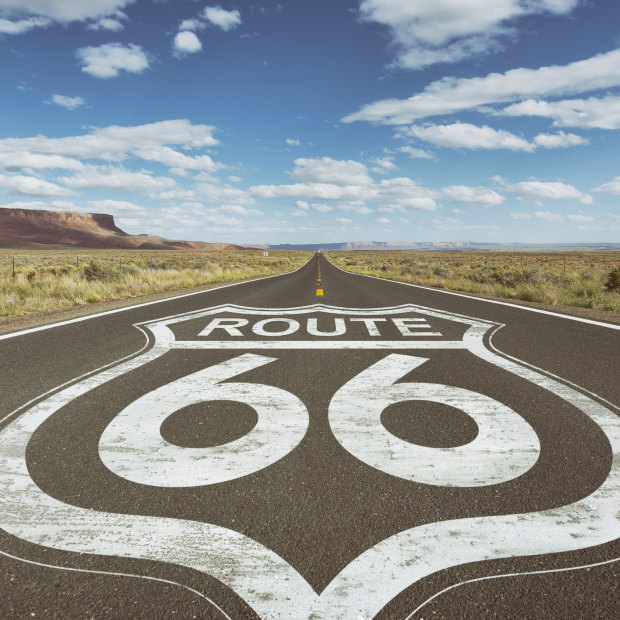
Kicks started … Route 66.Credit: Getty Images
Route 66 is a ghost highway. It officially vanished in 1985 – but try telling that to the good folk of Springfield, Missouri. This Springfield (one of 67 in the US) is nicknamed the Buckle of the Bible Belt, thanks to its hundreds of churches. Even while Uber-ing from the airport to my Route 66-themed motel, my driver confesses he glimpsed heaven the previous night as he hunkered down during a minor tornado.
A few years ago, a reporter calculated Springfield has six times as many churches as Chinese restaurants, which is saying something considering many residents are addicted to a local invention called cashew chicken. The city of 180,000 mostly God-fearing people is also the birthplace of another pivotal development – it was from here that a telegram was sent to federal officials on April 30, 1926, suggesting the new diagonal highway connecting Chicago, Illinois, to Santa Monica on the Pacific Coast be christened “66”. The designation was approved on November 11, the highway’s official birthdate.
Route 66 was born and Springfield, in the Missouri Ozarks, wrote itself into the history books (although Tulsa, Oklahoma, this year claimed the Capital of Route 66 title, as the guy who first noticed the 66 designation was available was a Tulsan). While this part of Middle America might be unfamiliar to many Australians, it’s the perfect place to start exploring the near-mythical highway that ran almost 4000 kilometres through eight states. With these states and their retro roadside attractions already gearing up for an influx of visitors in 2026, now’s the time to do the route as it was meant to be done: in a leisurely fashion, so you can shoot the breeze with characters you meet along the way.
Tracking down the route’s historic wisps of blacktop, superseded by more efficient but less interesting interstate highways, can take grunt work, though. Many Route 66 attractions can help, as they sell guidebooks describing exactly how to trace that journey back to simpler times. It also helps that, as the eight states increasingly recognise the power of Route 66 tourism, brown-and-white Historic Route signage has sprouted alongside the former highway, turning the ephemeral into something more concrete.
Time travel on four wheels
What do travellers hope to find – beyond photo opportunities – as they journey along what’s also called the Main Street of America? I have no idea, but my nostalgia trip starts on Springfield’s West College Street. We snap pictures of the 1929-built Rockwood Motor Court – a fine example of what’s known as giraffe-rock architecture (where sandstone or limestone is collected, sometimes split and then mortared in place, creating a pattern that resembles a giraffe’s hide) – and head to College Street Cafe. Inside the tiny diner, a breakfast of eggs, bacon, hash brown, toast and percolated coffee makes for a classic American diner experience right on Route 66. Before taking leave, we ink our name on the walls as many others have done.
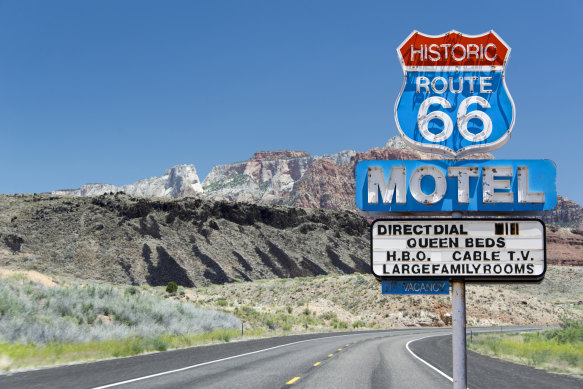
Old motel sign along the route.Credit: iStock
Right out front, a Route 66 badge is painted onto the road. We snap selfies then stroll over to the Route 66 Car Museum – a vast display space for businessman Guy Mace’s collection of historic and movie-themed vehicles, including a Batman-inspired 1971 Gotham Roadster and a Ghostbusters ECTO-1.
“I’m an unusual collector in that I drive most of my cars,” says Mace, whose favourite set of wheels is a bronze 1967 Austin-Healey, while the most expensive (valued at $US1.5 million, or $2,240,000) is a 1936 Horch. Many vehicles on the museum floor are on trickle chargers to keep their batteries in shape.
“If you want to see the true America … travel Route 66 and you’ll see a lot of small towns. People want to see the real America,” he says. With up to 40 per cent of the museum’s visitors drawn from overseas, Mace says: “It’s just incredible the mystique that Route 66 has worldwide.”
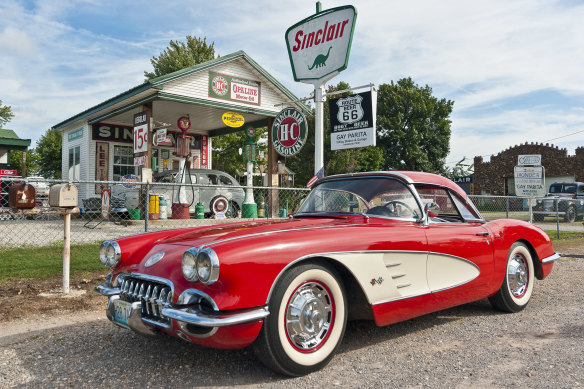
Gary Turner’s Gay Parita.
Equally amazed, even though he meets Route 66 tourists every day, is George Bowick of Gay Parita, a replica Sinclair gas station 37 kilometres west of Springfield on Old 66. The stop is a mere dot on the map but it illustrates how 66 is really about something other than landmarks: it’s about people.
Bowick is continuing the legacy of his gregarious father-in-law, Gary Turner, who died in 2015 but is fondly remembered as a route ambassador. He’d spend hours shooting the breeze with passers-by and giving tips for the best stops along the route. Some people thought that with the passing of the one-of-a-kind Turner (and his wife, Lena, just a few months later), that’d be the end of Gay Parita.
Clearly, they’d never met Bowick (he and his partner, Turner’s daughter Barbara, lived way off the route in Charleston, South Carolina, until duty called).
“Here in south-west Missou-rah, this stretch of Route 66 is known as the ‘ghost stretch’ because so many things have faded away,” says Bowick in his cigarette-roughened voice. He’s lounging on the porch of the gift shop-cum-museum from where, in summer, he watches goldfinches dive-bomb his sunflowers. On the quiet road out front, an oversized Route 66 painted badge provides a perfect photo op.
“We’re keeping all of Mister Gary’s traditions – we do things exactly the same way Gary did,” he says.
Perhaps not everything. It’s hard to know what Miss Lena would have made of the 3D Sinclair green dinosaur (the fuel company’s logo), christened Lena and gussied up with red lipstick and toenail polish, which has joined the memorabilia collection.
This memorable pit-stop has been saved but, because of the mom-and-pop scale of many little businesses along the route, some have shuttered while others, such as California’s Bagdad Cafe, are struggling to stay open.
Click and connect
If you think Route 66 is only about collecting clicks (on your camera) think again. It’s also about slowing down and chewing the fat. “Route 66 is just a road – it’s always been a road, nothing but a road,” says Bowick. “It’s always been about the people and, when folks are travelling Route 66, if they keep that in mind they will not have missed the boat on anything. You won’t meet a better bunch of people on the planet.”
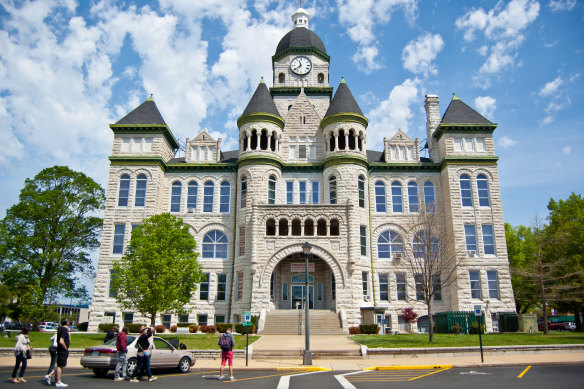
Carthage Courthouse.
Between his place and Missouri’s western border, we clock up other iconic Route 66 experiences. In Joplin, where Bonnie and Clyde holed up for several weeks in 1933 and a 2011 tornado ripped through the city, killing 158 people, art is helping recovery. Striking murals, along with half of a 1964 red Corvette, feature at the Route 66 Mural Park.
Fifteen minutes’ drive out of Joplin is the teeny-tiny Supertam On 66 Ice Cream Parlour and Superman Museum – home to 2500-plus items celebrating the Man of Steel along with ice-cream flavours such as Superman, Fat Elvis and Exhausted Parent.
On the way to Carthage, we snap the 66 Drive-In, which would make a very cool night out if you’re staying at the nearby Boots Court Motel. After showing us around the Streamline moderne-style motel where Clark Gable was a guest, manager Jeremy Morris takes us to another quirk. He lives in an old-timey house called The Parsonage at Red Oak II – a recreated community that is part art installation, part open-air museum just off Old 66. Visitors can stroll around the collection of early 20th-century buildings that include a Phillips 66 gas station, schoolhouse and general store.
A road divided
Detouring from the route to catch nearby sights was de rigueur for yesteryear’s road-trippers – so we follow in their tyre tracks. Near Springfield is the ride-through-in-a-jeep-drawn-tram Fantastic Caverns and, on the way to St Louis in the state’s east, you’ll find Meramec Caverns, which the outlaw Jesse James used as a hideout.
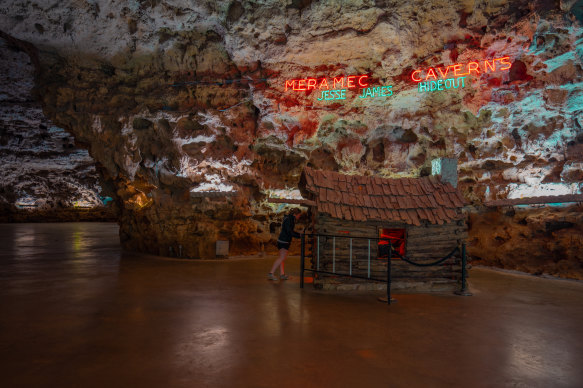
The Meramec caverns.
Yet Route 66 isn’t all nostalgia for everyone. As Springfield’s History Museum on the Square reminds us, journeying through segregated America was fraught for African-American motorists. To help them find places to eat, drink and stay, African-American New York City mail carrier Victor Hugo Green published The Negro Travellers’ Green Book from 1936-66 (a copy of the annual guidebook’s 1956 cover is displayed in the museum). The guide included Graham’s Rib Station and Motel in Springfield.
Springfield’s unofficial historian, David Eslick, said a 1960 campaign visit by then Vice-President Richard Nixon led to a significant moment for racial integration in the city. As Nixon’s press delegation included two African-Americans, a local hotel was forced to change its segregation policy. Two years later, it reversed its stance, saying the Springfield area “unfortunately is not quite ready” to accept desegregation “on a broad or unlimited scale”.

History Museum, Missouri.
The Civil Rights Act of 1964 made it illegal for hotels and motels to discriminate based on race.
Another poignant spot along the route is the Old Chain of Rocks Bridge on St Louis’s outskirts. Cyclists and pedestrians who cross the bridge, themed with Route 66 signage, to reach Illinois will find a plaque honouring two young women murdered here in 1991.
A ‘museum’ like no other
Among all its other monikers, Route 66 is also called America’s Longest Museum – and it’s easy to see why. Heading east from Springfield, we tick off the very silly fudge factory at Uranus, spend the night at Cuba’s classic Wagon Wheel Motel and explore the Old 66 displays at both Red Cedar Inn Museum and Visitor Centre and at Route 66 State Park (where the visitors’ centre is fashioned from a 1935 roadhouse that serviced the route).
St Louis provides more: riding to the top of the Gateway Arch, of course, but also diving into the wonders within (and outside) the sprawling National Museum of Transportation. Queuing at Ted Drewes Frozen Custard (the Chippewa location on the historic Route) for a cup of “concrete” is also a must.
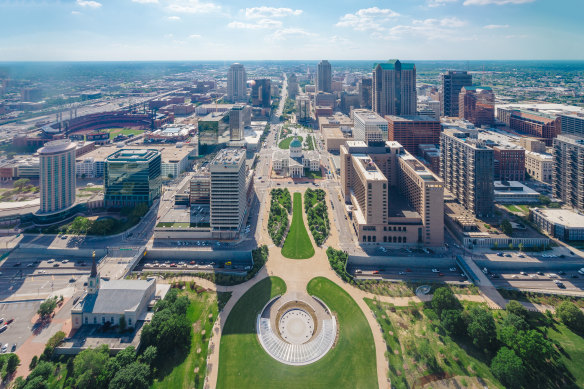
The view from the Gateway Arch.
The big city’s a buzz but it’s the smaller places – and the people there – who stick with you the most. At the Route 66 Museum inside the Lebanon-Laclede County Library, we meet Rod Reid. His family bought a Route 66 motel in 1961 so you could say the highway runs through his veins. Today, he’s chair of the national Route 66 Centennial Commission, which is pulling together ways to commemorate the highway’s big birthday.
“People want to get back to the roots,” says Reid. “They want to truly get a feel for what makes our country what it is and what it has been. They want to have that experience – not something that’s just manufactured.”
The writer was a guest of Visit Missouri and Travel South USA. See visitmo.com
Stops in seven other states
Between the route’s big-city bookends, travel through cornfields, the undulating Ozarks, Native American country, and cowboy and Hispanic history – with stops at these one-of-a-kind sights.
Illinois
Roll back to 1950 by heading to Rt 66 Skyview Drive-In at Litchfield in south-central Illinois. The theatre claims to be the only original drive-in still located along the road. We don’t know what the folks at 66 Drive-In in Carthage, Missouri, have to say about that – they opened for business alongside the route in 1949. The pre-television, post-World War II years were drive-in cinema’s golden age: it’s when motel guests would flock for an affordable night of entertainment convenient to their accommodation. See litchfieldskyview.com 66drivein.com
Kansas
Of the eight Route 66 states, Kansas is the one with the least amount of historic highway, with just 22 kilometres of the route angled across the state’s south-eastern corner. Nevertheless, stop at the Old Riverton Store to admire the 1925 building with its pressed-metal ceiling (the place is said to have inspired Pixar’s Cars movie). Just west of town is Marsh Arch Bridge, known as the Rainbow Bridge, the only driveable bridge of its kind along the route. See oldrivertonstore.com
Oklahoma
Pops 66 Soda Ranch, on the outskirts of Oklahoma City, is all your sugar-loaded, LED-lit, highly carbonated fizz fantasies bundled into one ultra-modern, extraordinarily photogenic roadside attraction. Opening in 2007, Pops delivers kitschy vibes with its 66-foot (20-metre) tall soda-bottle and straw landmark sculpture that puts on a vivid light display after sunset. Beyond the striking museum-like window display of row upon row of soft-drink bottles, you’ll find hundreds of soda flavours that range from regular to wacky (think dill pickle, celery, spaghetti and even kitty piddle). See pops66.com
Texas
They say everything’s bigger in Texas – everything, that is, except Route 66. Only 300 kilometres of highway originally crossed the Texas Panhandle in the north of the Lone Star State. However, it’s de rigueur to stop at the Midpoint Cafe (marking the route’s halfway point) in tiny Adrian for a slice of “ugly” pie. That’s if you haven’t already filled up on a bowl of chilli or green chilli stew at Amarillo’s GoldenLight Cafe, which opened alongside the route in 1946. See goldenlightcafe.com traveltexas.com
New Mexico
Plan to spend a night or three in Tucumcari, New Mexico. This city of just 5000 residents is home to a trio of carefully restored retro motels: the Blue Swallow Motel (with its drawcard neon sign, handy garage units and pink stucco exterior), Motel Safari (look for its distinctive camel sign and perhaps splash out on the rawhide or rockabilly suite) and the Roadrunner Lodge Motel (two motels merged into one). See blueswallowmotel.com themotelsafari.com roadrunnerlodge.com
Arizona
After greeting Giganticus Headicus (a Tiki-style lime-green roadside sculpture) in Antares, continue through Kingman to perhaps get your kicks – for real – from the burros strolling the streets of Oatman, a “living” ghost town that stages Wild West shoot-outs in western Arizona. These feral donkeys, descendants of 19th-century gold miners’ beasts of burden, have no hesitation in approaching visitors – usually to see if they can snuffle a snack. Arizona is also home to one of the route’s most kitsch stays: Holbrook’s Wigwam Motel. See oatmangoldroad.org sleepinawigwam.com visitarizona.com
California
Before reaching the end of the trail at Santa Monica Pier, make the desert highway less lonely by visiting Bagdad Cafe in Newberry Springs. This Mojave Desert landmark is a popular pit-stop (particularly for French travellers) thanks to a cult 1987 film. Bagdad Cafe was inspired by a real cafe that had long crumbled away so it was shot 80 kilometres away at the Sidewinder Cafe. A change of cafe ownership in 1995 brought about the clever silver-screen name change. Today, 83-year-old owner Andrea Pruett no longer serves food but, after successfully fund-raising to repair her cafe’s crumbling roof, still warmly welcomes visitors to stop by and add to her hodgepodge of memorabilia. See bagdad-cafe-usa.com
THE DETAILS
Fly
Delta (delta.com), American Airlines (aa.com), United (united.com)and Allegiant (allegiant.com) connect Springfield, Missouri, to US hubs such as Los Angeles, Atlanta, Houston and Dallas Fort Worth. Major car-rental companies, including Avis, Budget and Hertz, operate from the airport.
Visit
In Springfield, see Route 66 Car Museum 66carmuseum.com, History Museum on the Square historymuseumonthesquare.org and Fantastic Caverns missouriscave.com
West of Springfield, see the Route 66 Mural Park at 619 South Main Street, Joplin visitjoplinmo.com and Supertam On 66 Ice Cream Parlour and Superman Museum supertamon66.com
Heading east to St Louis, see Uranus uranusmissouri.com and Meramec Caverns americascave.com
In St Louis, visit the National Museum of Transportation tnmot.org and Ted Drewes Frozen Custard teddrewes.com
Stay
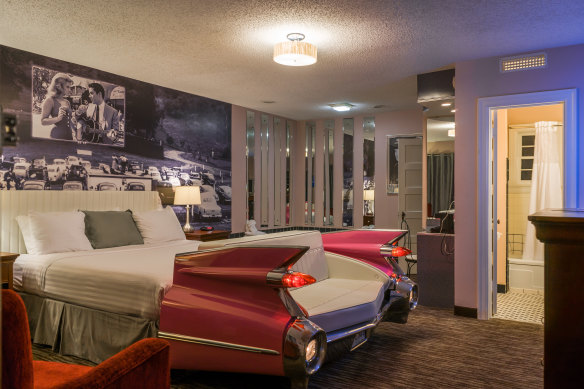
Where dreams and reality collide … Best Western, Route 66 Rail Haven.
Best Western Route 66 Rail Haven features motel-style rooms and three themed suites (Elvis, Marilyn and Wild Bill Hickok) from $US81 ($121) a night; Springfield, bestwestern.com; Boots Court Motel, Carthage from $US115 a night, bootscourt66.com; Wagon Wheel Motel, Cuba from $US82 a night, wagonwheel66cuba.com; St Louis Union Station Hotel, Curio Collection by Hilton from $US210 a night, hilton.com